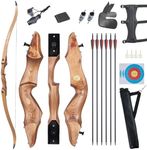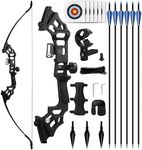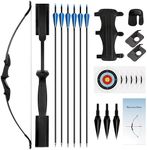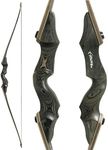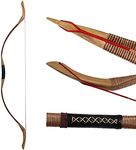Buying Guide for the Best Recurve Bows
Choosing the right recurve bow is essential for both beginners and experienced archers. The right bow will enhance your shooting experience, improve your accuracy, and ensure comfort during use. When selecting a recurve bow, consider factors such as your skill level, intended use (target shooting or hunting), and personal preferences. Understanding the key specifications of recurve bows will help you make an informed decision that aligns with your needs and goals.Draw WeightDraw weight refers to the amount of force required to pull the bowstring back to its full draw length. This is an important spec because it affects the power and speed of your shot. Draw weight is typically measured in pounds. For beginners or those with less upper body strength, a lower draw weight (15-30 lbs) is recommended to ensure comfort and prevent injury. Intermediate archers might opt for a medium draw weight (30-45 lbs), while experienced archers or hunters may prefer a higher draw weight (45 lbs and above) for more powerful shots. Choose a draw weight that you can comfortably handle for extended periods.
Bow LengthBow length is the measurement from tip to tip of the bow when it is unstrung. This spec is important because it influences the bow's stability and ease of use. Shorter bows (48-58 inches) are more maneuverable and suitable for younger archers or those with a shorter draw length. Medium-length bows (58-62 inches) offer a balance of stability and maneuverability, making them ideal for most adult archers. Longer bows (62 inches and above) provide greater stability and are often preferred by target archers. Consider your height and draw length when selecting the appropriate bow length.
Riser MaterialThe riser is the central part of the bow that you grip, and its material can affect the bow's weight, durability, and feel. Common materials include wood, aluminum, and carbon. Wooden risers offer a traditional look and feel, often preferred by those who appreciate aesthetics and a classic design. Aluminum risers are durable and provide a modern look, suitable for those who prioritize strength and stability. Carbon risers are lightweight and strong, ideal for archers who want a high-performance bow with reduced weight. Choose a riser material that matches your preference for weight, durability, and style.
LimbsThe limbs of a recurve bow are the flexible parts that store energy when the bow is drawn. They are typically made from wood, fiberglass, or carbon. Wooden limbs offer a traditional feel and are often more affordable, suitable for beginners or those who prefer a classic look. Fiberglass limbs are durable and provide consistent performance, making them a good choice for intermediate archers. Carbon limbs are lightweight and offer superior performance, ideal for advanced archers seeking precision and speed. Consider your skill level and performance needs when selecting limb material.
Takedown vs. One-PieceRecurve bows come in two main types: takedown and one-piece. Takedown bows have limbs that can be detached from the riser, making them easier to transport and allowing for limb upgrades as your skill level improves. They are ideal for archers who travel frequently or want the flexibility to change draw weights. One-piece bows are a single, solid unit, offering a traditional look and feel. They are often preferred by archers who value simplicity and a seamless design. Consider your lifestyle and future needs when deciding between a takedown or one-piece bow.
